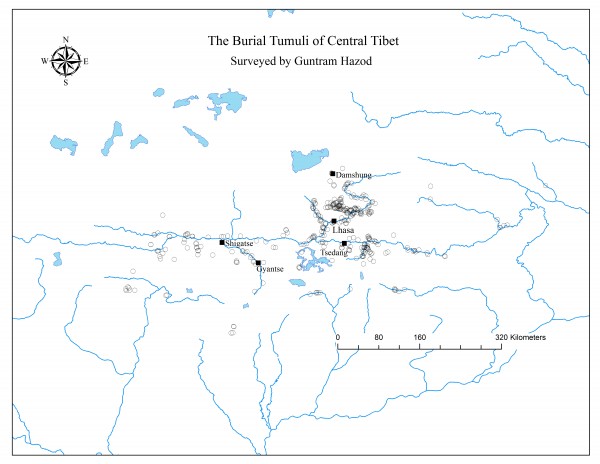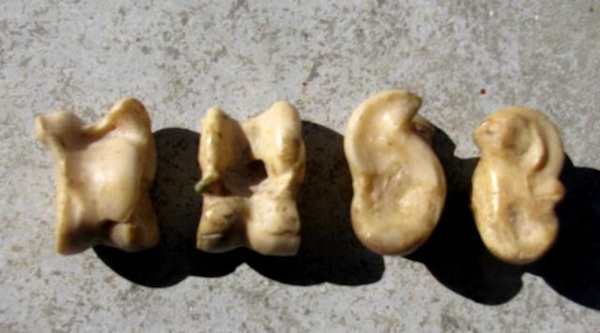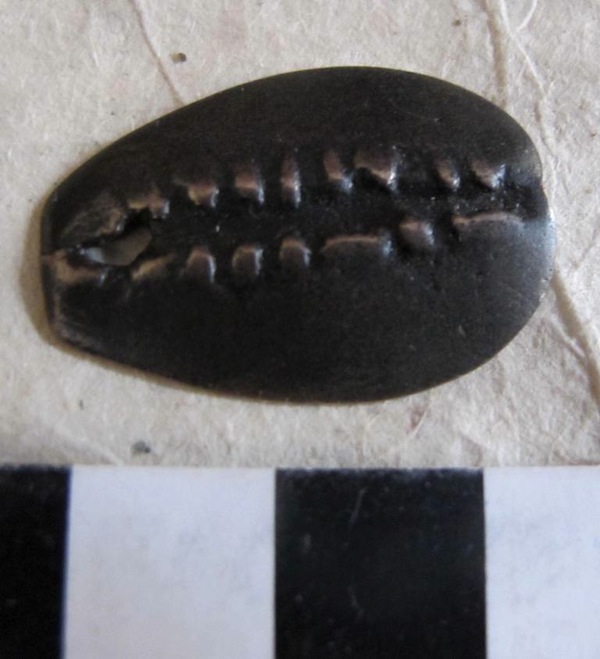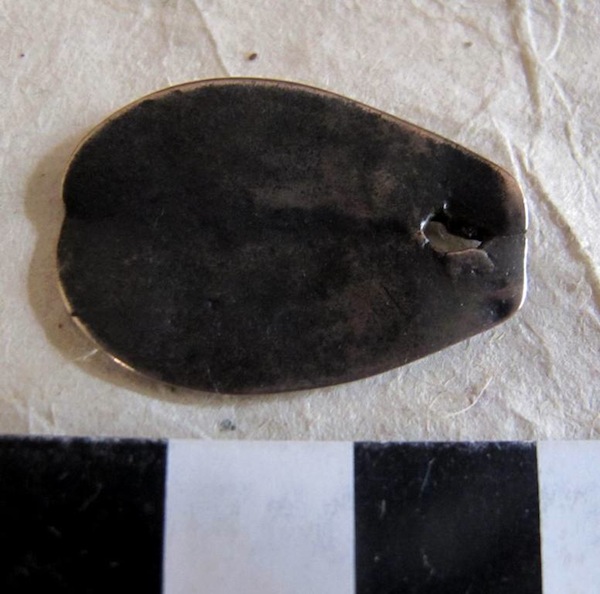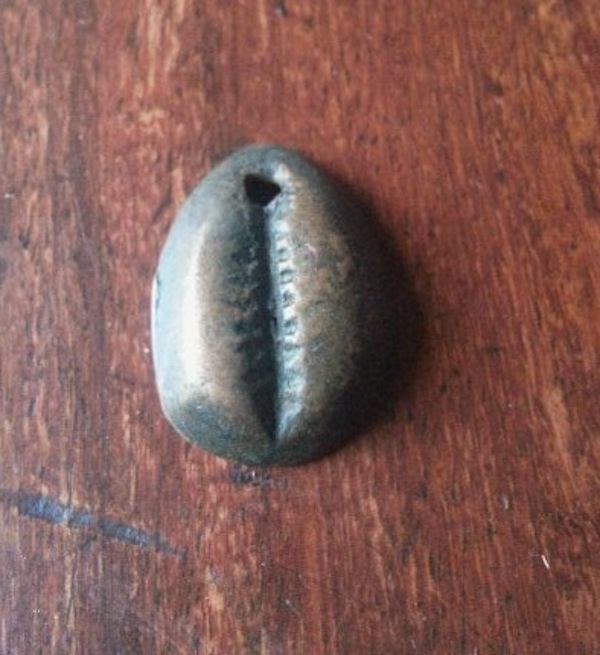
May 2014
John Vincent Bellezza
Greetings and get ready for another Flight of the Khyung! This month’s newsletter has four features ranging from ancient glories to contemporary threats, taking you far and wide.
The first feature is an essay dispelling the commonly held notion that Tibet has a singular cultural identity on par with individual tribal groups or subsistence agriculturalists/pastoralists. The second feature reviews Tibetan Tumulus Tradition, an online resource for the study of ancient Central Tibetan burial monuments. The third article pertains to two types of copper alloy objects with far-ranging connections to the rest of Eurasia, opening up an exciting new area of inquiry into Tibetan cultural history. The fourth and final feature in this newsletter reports on the recent destruction of archaeological monuments in Upper Tibet.
Don’t Devalue Tibet: It is not merely a ‘culture’, it is a ‘civilization’
In this essay, Tibet is viewed in the widest possible terms and shorn of any modern political attributions. I will outline why this Tibet constitutes a ‘civilization’, touching upon a wide spectrum of disciplines and sources. The arguments I make could form the theme of an entire book, but I have only a few paragraphs to devote to them here, so please bear with me. Many of the matters discussed are done so in the most cursory of fashions. Still, I trust my thesis will be shown to be sound.
Tibet was and is a civilization, not a single culture. The ‘Tibet’ I am talking about here is the geographic and cultural complex, which extends well beyond the borders of the TAR, or any other contemporary political entity, to encompass the entire Plateau and adjoining high mountain tracts. That Tibet is a distinctive civilization was given currency by Tibetologists of the last generation, including the highly respected R. A. Stein, David Snellgrove, and Hugh Richardson. Unfortunately, many writers on Tibet seem not to have taken heed.
In both popular and academic writing, we often read of “Tibetan culture”, conceived of as the sum total of the Tibetan experience. This overarching concept is misleading, because it diminishes the scope of Tibet and her august achievements over the course of history. It is also inaccurate to refer to a singular Tibetan culture, linguistically and ethnographically speaking.
It must be left to the linguists to decide, but at last count there were no less than thirty languages spoken on the Plateau and in adjacent high mountain areas. Some of these languages are closely related (as Spanish and Italian are) as part of the Bodish branch of languages. Others are more distantly connected as members of the Bodic family of languages. What is not often appreciated is that there are languages in eastern Tibet that do not even belong to the Bodic family. Some of the living languages of the deep valleys of Gyalrong, as well as the extinct language of Zhang Zhung (and others), fall into this category. Certain non-Bodic languages of Tibet find a place in the Qiangic language family. For a classification of Tibetic languages (not others spoken on the Plateau), see author Nicolas Tournadre (with partial bibliography of his important linguistic work) at: http://en.wikipedia.org/wiki/Tibetic_languages
What is frequently referred to as ‘cultural Tibet’ or ‘greater Tibet’ is highly diverse ethnographically speaking. The Tibetan Plateau is host to a variety of groups with distinctive cultural identities such as the Khampa, Golokpa, Minyakpa, Amdowa, Upa, Tsangpa, Drokpas, Monpa, Adi, Sherpa, Lopa, Töpa, Ladakhi, Balti, etc., etc. These groups tend to view and organize themselves as endemic organisms, each with its own religious traditions, social customs, architecture, costumes, histories, ethnic origins, etc. Thus there is not one contemporary Tibetan culture, but twenty, thirty, or forty different ones, depending on how one defines a ‘culture’.
Although there is no universally agreed upon definition, civilization can most simply be described as a cultural and technological system, characterized by a high degree of material and intellectual development. The possession of large monuments, literature, complex religion, stratified social systems, agriculture, centralized political control, urbanization, extensive trade, and industry are traditionally used as benchmarks of civilization. In the 20th century, assessing civilization on physical criteria alone came under question. A more modern definition of civilization considers the ethical and spiritual dimension, conceptual and behavioral innovations that encourage widespread human well-being and illumination. Civilization is often contrasted to other forms of collective human experience such as that represented in tribal, hunting-and-gathering, and itinerant societies.
Thus the badge ‘civilization’ has been given to a number of impressive ancient regions such as Greece, Rome, Egypt, Babylonia, Persia, India, China, Mesoamerica, Andes, etc., areas synonymous with the rise of complex human orders that meet most or all of the criteria set forth above. I contend that Tibet must be included in their elite ranks, at least from the Metal Age until the modern period, for Tibet also possessed the same set of fundamental traits. It is true that writing and literature only came later to Tibet (7th century CE), and urban centers have been traditionally restricted in number, but Tibet meets in ample measure all other chief criteria enumerated above.
Agriculture spread widely in Neolithic Tibet, one of the most important building blocks of civilization. Already by the Iron Age, the Tibetan Plateau was home to an impressive range of monuments including citadels, temples, and necropolises. These structures, as well as many spectacular material objects, are unique to Tibet (as is the Tibetan human genome), setting her apart from neighboring civilizations. The assemblage of archaeological monuments varies from region to region, indicating that the Tibetan Plateau was already a very culturally diverse place more than 2000 years ago. Recent archaeological discoveries in western Tibet have uncovered trade links with the Indian Subcontinent, Central Asia, and China in the second half of the first millennium BCE and early first millennium CE.
Greater Mongolia, especially in the Bronze Age and early Iron Age, was a seat of civilization, but its fortunes waned over time. Under the effects of climate change, much of Mongolia’s agricultural potential was lost and most of the remaining population shifted to a nomadic existence. On the other hand, Tibet retained a robust system of sedentary settlement.
In the early historic period (circa 650–850 CE), the various peoples and cultures of the Tibetan Plateau were unified under the Pugyal (sPu-rgyal) empire. This was a time of a strong centralized state, a characteristic political feature of civilization. The emperors (btsan-po) were the first to create a sense of a greater Tibetan nation, built up from the pre-existing proto-nations of the Plateau (Bod, Zhang Zhung, Sumpa, Azha, Minyak, Jang, and Mon). Subsequently, the introduction of Buddhism helped to further weld the Tibetan Plateau into a web of interrelated cultures, which continued to function socially, and sometimes politically, as more or less discrete regional entities. Buddhist Tibet’s high level of spiritual and ethical development is well documented; under a progression of dominant political regimes, that was the state of affairs until the mid-20th century.
Covering some 2,500,000 km², the Tibetan Plateau is a vast territory. Many so-called cradles of civilization were considerably smaller in size. When all the aforementioned factors are examined together, Tibet clearly emerges as one of the centers of world civilization. Yet her civilizational status is not well recognized.
Part of this neglect has to do with general ignorance about Tibet. Her civilization is not as well documented as others. While other major civilizations have been subjected to archaeological scrutiny for a century or more, it is only in recent years that substantive archaeological exploration has taken place in Tibet. And archaeological inquiry remains in its infancy, impeding our knowledge about the true extent of Tibetan historical and cultural attainments.
Tibet’s closure to the world-at-large some three centuries ago, and continuing in certain ways to the present day, does not help matters either. As a result, Tibet has assumed a mythic identity, one that is not very amenable to discovering the true nature of her civilization. As we know, civilization is not always pretty with its gross social and economic disparities. Such a picture of Tibet does not fit well with the fairy-tale perspective that some like to propagate. The prejudices of surrounding civilizations have not helped either. As Tibet declined politically, economically, and culturally over the last few centuries, she became easy to write off as a backwater with little relevance to the rest of the world. The hermetic tendencies of some monks and clerics only served to strengthen this view.
Review of the website called “Tibetan Tumulus Tradition”
In the last couple of years, an excellent new online resource for Tibetan archaeology has appeared on the worldwide web. It is called Tibetan Tumulus Tradition, a website dedicated to the study of the ancient burial monuments of Central Tibet. Tibetan Tumulus Tradition is the brainchild of Dr. Guntram Hazod, the project leader and principal fieldwork and textual studies specialist. For anyone interested in Tibetan archaeology, this work is highly recommended.
See: (http://www.oeaw.ac.at/tibetantumulustradition/home/)
The homepage of Tibetan Tumulus Tradition, entitled “The Burial Mounds of Central Tibet”, provides an introduction to the tumuli of the region, which are dated from no later than the 4th century CE to the early 10th century CE. Dozens of cemeteries are charted on the website and more documentation is planned. Tibetan Tumulus Tradition is the first work to systematically and comprehensively compile data about pre-Buddhist mortuary archaeology from all regions of Central Tibet. This website has become an indispensible tool in the study of early Tibet and for assessing its place in the central Eurasia of ancient times.*
Until the appearance of Tibetan Tumulus Tradition, the most extensive catalog of Central Tibetan burial monuments was the TAR volume entitled An Atlas of Chinese Cultural Relics (2010: Institute of Archaeology, Chinese Academy of Social Sciences). This work covers the entire spectrum of archaeological monuments in Tibet, prehistoric and historic. As valuable as this volume is, less than 5% of TAR’s archaeological sites are registered in it.Tibetan Tumulus Tradition is a well-designed and easy-to-use scholarly website. Especially noteworthy are its high quality graphics, consisting of lavish photographs and satellite imagery. The design of the website is conducive to the addition of more information; a useful attribute, as more expansion in the future is promised by the authors.
Much basic information about Central Tibetan mortuary culture is found by clicking on the tab called “Thematic Introduction”. It features various essays on the history, typology, and functions of burial mounds and ancillary structures. Special attention is given to the geographic locations of tombs and their pillage over time. Another tab takes readers to tables comprised of basic data about various cemeteries organized on a county by county basis. The website also boasts a series of regional maps and an extensive bibliography.
Tibetan Tumulus Tradition is hosted by the Austrian Academy of Sciences (Österreichische Akademie der Wissenschaften). The research work and exploration on which the website is based is conducted under the auspices of the Tibetan Academy of Social Sciences (TASS), Lhasa; the Institute of Indology and Central Asian Studies, Leipzig University; and the Ludwig Boltzmann Institute for Archaeological Prospection and Virtual Archaeology (LBI ArchPro), Vienna.
Bronze cowries and a bronze knucklebone: Markers of cosmopolitanism in the ancient artifacts of Tibet
Introduction
This is a preliminary report on copper alloy imitation cowries and an astragalus (talus, knucklebone) discovered in Tibet. To my knowledge, this is the first attempt to study these classes of artifacts and outline their historical and cultural affinities with other parts of Eurasia. The examination of these objects opens up a new channel of inquiry into Tibet’s role in ancient Eurasia.
There is far more scope for inquiry into Tibetan cowries and astragali than this article can possibly offer. Given the many archaeological and ethnographic angles on this subject, I believe it is worthy of a book or dissertational project. How nice it would be if my paltry efforts here were to spur on such an undertaking!
Cowries and astragali of sheep and goats are among the most widely distributed objects in Eurasia in both ancient and contemporary cultural contexts, and Tibet is no exception. As part of my ongoing efforts to highlight the many parallels between Tibet and other regions of Eurasia, this article examines copper alloy imitations of these iconic objects. One copper alloy casting of an astragalus and at least several of cowries have come to light in Tibet. According to popular Tibetan conception, these tiny objects are thokchas (thog-lcags), talismans believed to be of celestial origins. As we shall see, the worldly qualities of these two kinds of objects are just as fascinating as the myths of origins Tibetans attach to them.
Ancient bronze astragalus in Tibet
Let us begin with the astragalus, one of the bones making up the tarsus, specifically that found in the rear ankles of sheep and goats. The astragali of sheep and goats are small, squarish bones that have been used for a variety of purposes in Europe, the Middle East, Central Asia, and the Indian Subcontinent since the Iron Age. Most famously, astragali were used as gaming pieces. It is generally believed that they are the precursors of jacks and dice, but more research is required to confirm this theory. In ancient Greece and Rome, copper alloy imitations of astragali were cast as gaming pieces (and perhaps had other functions).
The life-like copper alloy astragalus discovered in Tibet may well be of indigenous manufacture. As we shall see, this bone occupies a seminal place in Tibetan culture. In any case, it differs in minute details and in general form from the European and Chinese bronze astragali referred to in this article. Nevertheless, astragali possess a relatively simple form, making a stylistic analysis particularly difficult. Of course, a metallurgical analysis of the Tibetan specimen might help to pinpoint its place of manufacture, or at least differentiate it from those made in ancient Europe and China. It appears that imitation astragali were also fabricated from rock crystal and ivory in Tibet. Pieces of turquoise and coral were carved into the shape of an astragalus as well and used as settings in rings. These rings are still worn in Tibet.

Fig. 1. Copper alloy astragalus (plantar side) obtained in Tibet in the 1980s or early 1990s, Shang Nyima collection. Mr. Shang Nyima, an expert on Tibetan antiques, highly values this artifact as an authentic example of a native Tibetan object. His sentiments are influenced by the role sheep astragali have traditionally played in the life of Tibetan children.

Fig. 2. Dorsal view of same copper alloy astragalus discovered in Tibet (3.2 cm in length). The major anatomical traits of the bone are recognizable in this cast object.
That this copper alloy astragalus retained it cultural relevance as having talismanic properties sets it apart from those recovered from European and Chinese archaeological contexts. Unfortunately though, by not having a firm provenance, the actual place of manufacture and original cultural functions associated with this artifact remain unknown.
Unlike the bronze astragali of ancient Rome and Greece, the Tibetan specimen has a fine patina, indicating that it was never buried underground, but instead was passed on through the generations. The age of this artifact is debatable, except to vaguely say that it appears to be of considerable antiquity. Unlike more intricate zoomorphic and anthropomorphic thokchas, there are few visual clues with which to gauge its historical placement. The color, texture, and patina of the metal (a true bronze?) are similar to many other so-called thokchas, which date to the protohistoric period (100 BCE to 600 CE), early historic period (600–1000 CE), and vestigial period (1000–1300 CE). At this juncture, I cannot be any more precise about the age and origin of the bronze astragalus found in Tibet. While this object appears to be of Tibetan origin, this cannot be verified with the available evidence.
Although the origins of the bronze astragalus discovered in Tibet are unclear, the hoary cultural status of this bone is widely agreed upon by Tibetans. In addition to my general acquaintance with this object in the pastoral regions of Tibet, I have recently interviewed a considerable number of Tibetans to obtain more information about astragali (and cowries).
The astragali of sheep and goats is known by a variety of names in Tibet. In Kham and Amdo (eastern Tibet) and in the Hor and Apha Hor regions of Nakchu, it is generally called thege (the-ge). This word, by virtue of its orthography, appears to be of ancient origins. Its etymology can possibly be traced to the Old Tibetan language or perhaps to the Zhang Zhung language (both the and ge occur in the lexicons of this extinct tongue). In parts of Amdo such as Ngawa (rNga-ba), the astragalus is called weke (be-ke), a regional variant of the-ge.
In Lhasa and southern Tibet, the astragalus is called achuk (A-cug: often pronounced ‘abchuk’). In Tsang and western Tibet (including Tingri, Kyirong, Purang, and the western Changthang) the astragalus is often called longmo (long-mo,) a constituent part of the ankle joint (long-tshig/long-rdog). In Spiti a sheep or goat astragalus is called muklo (mug-lo), a word of possible Zhang Zhung origins. There are also local names for sheep and goat astragali in Tibet. For example, in the Lingtshang (Gling-tshang) dialect of Dege (sDe-dge), this bone is designated saga (sa-ga), while in Ganze (dKar-mdzes) and Drakgo (Brag-’go), located further east in Kham, it is the adram (A-’gram, spelling?). There are likely to be other synonyms for astragalus in the sundry dialects of Tibet.
Interestingly, the term the-ge or other common Tibetan names for astragali do not appear in the Dunhuang manuscripts (at least the ones searchable online). However, in the Dunhuang text ITJ 739, the term cho-lo (referring to dice or dominoes) occurs four different times in the explication of the positive and negative outcomes of a divination ritual. Perhaps, then, by the time these early divinatory documents were written down (8th to 10th centuries CE), dice had replaced astragali in divination, at least in more formal settings.
Knucklebones
Astragali of sheep and goats are known all over Tibet as children’s toys. I have seen herders’ children use astragali to represent livestock in their miniature play camps.* More importantly, astragali are gaming pieces in what is known as knucklebones in English (among many other names). Knucklebones appears to be the most ancient and ubiquitous of Tibetan games. As naturally-occurring objects, astragali probably have primitive cultural underpinnings, a perception reinforced by Tibetans who assign their use to remote antiquity. The small, solid, compact astragali of sheep and goats make ideal gaming pieces. Knucklebones may well be the precursor of the well-known Tibetan dice game of sho.** In both Tibetan knucklebones and dice, the outcome of each throw is determined by the assigned value of the upright face of the piece.
Use of astragali of animals as toys is mentioned in Rinjing Dorje, 1987: Food in Tibetan Life, London: Prospect Books. For a new study of sho, see Murakami, D, 2014: “Aspects of the Traditional Gambling Game known as Sho in Modern Lhasa — religious and gendered worldviews infusing the Tibetan dice game”, in Revue d’Etudes Tibétaines, no. 29, pp. 245–270.See: http://himalaya.socanth.cam.ac.uk/collections/journals/ret/pdf/ret_29_08.pdfIn modern Tibet, sho has mostly replaced knucklebones as the game of choice among men. However, as is often the case with ancient traditions, knucklebone games are much wider in scope and have ceremonial and sacred dimensions that sho does not possess. Both sho and knucklebones are exhilarating and emotive games, but the latter also has a deep cultural significance the former lacks. I am told that elders would encourage the playing of knucklebones among youth, claiming that it was superior to sho or mahjong (of Chinese origins), games that are considered morally questionable. Nowadays, with mandatory schooling, modernization, and extraneous cultural influences, knucklebones is rapidly disappearing in Tibet. Elders fondly remember their youthful days playing it.
Traditionally, astragali had considerable value because only so many could be obtained at any given time. Only with the slaughter of goats and sheep would they become available. Thus a single individual had access to a limited number of them. Their value was further enhanced by specially preparing the bone in a variety ways. These included chemical treatments and ornamentation.
There are many different knucklebone games in Tibet, each with their own rules and customs. They are played by both males and females. The games vary from region to region, and are particularly popular among the pastoral sections of the population. Knucklebones is sometimes associated with gambling. The basis of these games is the competitive tossing or shooting of astragali. This is referred to as ‘to throw’ (rgyab/rgyag), ‘to strike’ (’khrab), and ‘to race’ (rgyug). In places like Nyanrong (Snyan-rong) in Hor and Jyekundo (sKye-rgu-mdo) in Kham, entire villages come out in their best clothes to enjoy knucklebones during the New Year (Lo-gsar) celebrations.*
According to an account by Giuseppe Tucci and Namkhai Norbu, beginning on the third day of the Tibetan New Year celebrations and continuing for some days afterwards, residents of all ages in Jyekundo played a knucklebone game called ‘goat astragalus sheep astragalus’ (ra-the lug-the) with colored bones. See G. Tucci, 1966: Tibetan Folk Songs from Gyantse and Western Tibet. With two appendices by N. Norbu, Ascona: Artibus Asiae.Each of the six sides of the squarish astragalus has a special name and value. In some instances the four main faces are equated with the cardinal directions. More commonly, the six sides are identified with animals and other things as follows:
- Plantar side – sheep: second-most superior of the four main faces. This arched side is also called gang (gang), gyak (brgyags), and drang (’grang), as in a full stomach after eating.
- Dorsal side – goat: second-most inferior face. This side with the round hollow is also called tongpa (stong-pa) and tok (ltogs), as in an empty stomach.
- Lateral side: horse: most superior face. This side has a pronounced rim and is also called the ‘front’ (kha).
- Medial site: donkey or mule: most inferior face. This flatter side is also called the ‘base’ (gsham).
- The posterior tip with the two horn-like extensions: horned eagle (khyung). In Hor regions these protuberances are called ‘fingernails’ (sen-mo). In certain games this is the best of the six sides of an astragalus.
- The anterior tip with the two rounded ends has various names in Tibetan. In parts of Kham, it is referred to as the dog’s hind-end (khyi-rkub). In Hor regions, it is called the ‘rear end’ (Ong). In pastoral regions of western Tibet, is it the ‘tiger’ (stag). In some games, this is the worst of the six sides of an astragalus.
For gaming, the lateral and medial sides of astragali are carefully filed and polished, giving them a smoother and more regular surface. The pointed posterior end is sometimes filed down as well. By working an astragalus in this manner, it becomes faster, and will flip, spin, and slide in a less erratic manner. I have seen sleek antique astragali gaming pieces with rich patinas that have hardened with age as moisture is slowly lost, and perhaps through chemical treatment as well. These are true heirlooms, which nowadays are often forgotten or sold off for a pittance. The decorated cloth or leather sacks in which gaming and divinatory astragali are stored are called thekhuk (the-khug).
Probably the most universal game using knucklebones in Tibet is the ‘knucklebone strike’ (the-ge rgyab) or ‘knucklebone race’ (the-ge rgyug). This game is likened to a horse race. The players begin by each tossing an astragalus on the ground. Those that come up on the horse side are the last ones in the race. The remaining astragali are tossed, excluding those that land on the horse side, until only two pieces remain. These two players then begin to throw their pieces, striking each other to prevent one from remaining on the horse side. The winner of the ‘horserace’ is the first astragalus to stay on the horse side after a round of striking.
Another common Tibetan knucklebone game is called thepu gyab (the-spu rgyab). This fast-moving game entails the striking of opponent’s astragali in order that one’s own astragalus remains in the most advantageous position (horse and horned eagle sides). In a series of rounds, players try to capture the most highly valued astragali of their rivals. The game of thesho (the-sho) is played like the Tibetan game of dice.
An elaborate Tibetan knucklebone game is makthe (dmag-the: ‘army knucklebones’). In this game a large playing field is set up with groups of astragali piled up in different ways to represent a king, two ministers and eight generals. The king is placed in the most protected position in the rear of the playing field, in front of which are placed the ministers and then the generals. In addition to these piles of astragali, there are many individual pieces representing soldiers (dmag-mi). It is these army men that are flicked with the fingers by two or more players in order to upset the piles representing the king, ministers, and generals. The player possessing the last king standing is the winner. This energetic game is very challenging since the soldiers tend to increasingly obstruct the playing field, forcing shooters to adopt various offensive and defensive strategies. Tibetans report that there are other knucklebone games and variations on the few games I have briefly described.
Astragali, of course, naturally occur as light-colored bones. They are, however, colored by Tibetans using various techniques, a noteworthy demonstration of their skill and ingenuity. Many colored astragali are given names from Tibetan horse terminology, because this bone, when resting on its medial side, is said to have the shape of a horse. This explains an epithet for the astragalus found in some western Tibet pastoral regions: tapa longmo (rta-pa long-mo), the ‘horserider astragalus’. Ancient pointed microliths (rdo mdung-rtse: ‘stone spearpoint’ ), which are quite common in Upper Tibet, served as the horseman that was placed on top of the astragalus in children’s games. Another epithet for this bone in western Tibet is ‘full-hungry’ (’grangs-ltogs), as in the stomach before and after eating. This nickname reflects the variable outcomes, positive and negative, in gaming and divination.
Some names of different colored horses applied to describe various astragali can be traced to Old Tibetan literature. During games, there are different verses spoken for each type of astragalus. This more-or-less formalized speech is known as the ‘calling of the astragalus’ (the-’bod). The lines spoken, some of which are of ancient origins, vary from place to place and region to region. This constitutes an important oral tradition that deserves far more scrutiny.
Among the many types of Tibetan astragalus gaming pieces are the following:
- Sakpa (bsag-pa: ‘ochre one’): An astragalus thickly coated in red ochre and named after a reddish horse.
- Ta ngangpa (rta ngang-pa: literally, ‘goose-horse’): An astragalus upon which ochre is lightly applied. It is then covered in mud and gently heated in a fire until assuming an orange tint. It is named for a horse with orange highlights.
- Ta gyawo (rta rgya-bo): This gaming piece is made by covering an astragalus in yak manure and gently heating it in fire. It is named for a horse with brownish coloring and yellowish face markings.
- Olwa tingkar (’ol-ba rting-dkar): An astragalus darkened by the application of manure but in such a manner that the rounded anterior is left white. It is named after a black horse with white fetlocks.
- Gyawo dongkar (rgya-bo gdong-dkar): A dark-colored astragalus but with the horn-like posterior tips left white. This nomenclature denotes a brownish horse with yellowish face markings and a white spot on the forehead.
- Tadrokar (rta gro-dkar): An astragalus with dark lines painted along the edges. It is named for a gray horse with white markings.
- Saktra and Martra (bsag-khra and dmar-khra): Astragali and horses with red and light-colored markings.
- Ngoril and Serril (sngo-ril and ser-ril): A blue astragalus and a yellow astragalus respectively. Their names reflect the manner in which the bones are rolled in dye to give them color and the way in which they spin during gaming.
- Jasödok (Ja-bzos-mdog: literally, ‘tea-cooked color’): A purplish astragalus created by boiling the bone in a very strong solution of tea.
- Sokkar (sog-dkar: literally, ‘white shoulder blade’): An astragalus with the arched portion on the sheep face left white on an otherwise darkened bone. This white spot is said to resemble a shoulder blade.
- Ongdo (Ong-do: literally, ‘buttocks’): A white astragalus darkened on its rounded anterior.
- Bü-the (sbus-the: literally, ‘swollen astragalus’ in the Hor dialect; equivalent of Tibetan ’bur): Astragali from immature sheep and goats. The less defined features of the juvenile bone are thought to make them look like they are swelled up.
Astragali are also classified as to whether they come from castrated sheep (shab-zan, spelling?) or stud rams (lug-rub-bzang/lug-thug). These astragali are called shabthe (shab-the) and rubthe (rub-the) respectively. Astragali are also classified as mother (mo) and father (pho) bones, reflecting their bilateral arrangement in sheep anatomy. In the ‘father astragalus’ (pho-the) the posterior horn-like extension faces outward when the goat face is rested against the right palm. In the ‘mother astragalus’ (mo-the) the horns or fingernails point outwards in the left palm.
Fancier types of astragali were made by adults for gaming. One of these is the thoril (mtho-ril), an astragalus in which lead studs are placed into small holes bored in its four main faces. The posterior horn-like extensions are also filed down, as is the rounded arch on the sheep side of the bone. These actions create much faster playing pieces and ones that are more likely to land with the superior sheep and horse faces upright. Sometimes a turquoise was inserted into the hollow on the goat side of the astragalus.
Other traditional functions of astragali in Tibet
Besides recreation, ovicaprid astragali have a number of other functions. These alternative uses also appear to be of ancient origins. One function for the astragalus was as a calculating instrument in keeping accounts. In one system, an astragalus is equivalent to a 100 units of something in weight or number. Small sticks called chushing (bcu-shing) were each used to represent ten units of something. These accounting pieces were stored in a sack and consulted over the long-term to determine one’s financial position.
Astragali are used in Tibetan divination (the-mo: ‘astragalomancy’). In this kind of divination, the six sides of the bone have the same names as they do in gaming. According to the way in which a tossed astragalus falls, it is thought to auger a certain outcome or destiny. In some forms of astragalomancy, more than one bone in different colors was used. Unlike in games, astragali used in divination are thrown on a table or other clean surface, not on the ground. New and well-formed astragali are selected for this purpose. The use of astragali in divination must have preceded forms of prognostication employing dice and dominoes (cho-lo).*
On divination by dominoes (sbag), see Namkhai Norbu, 2009: The Light of Kailash: A History of Zhang Zhung and Tibet, vol. 1. Merigar: Shang Shung Publications, pp. 204–2010.Astragali are also tied together in Tibet to form long garlands (the-star). These are hung in kitchens and on the ‘father pillar’ (west pole) of a black yak hair tent, as harm repulsing and good-fortune bestowing talismans. In pastoral areas, it is thought that such a garland prevents a tent from being struck by lightning and livestock from being eaten by wild animals.
A special talisman is a particularly large astragalus with very prominent horn-like protuberances whose tips join. This is called ‘great fingernail’ (se-chen). Typically, a string was tied through the natural loop and the bone placed somewhere for safekeeping or added to the head of a garland of other astragali. Sometimes children would wear this most precious of astragali as a status symbol and good luck charm when playing knucklebones. It is reported that astragali may have been used in the marriage ceremonies of western Tibetan herders, but this custom seems to have completely died out.
In the Hor region of Nyanrong (and possibly in other regions as well), there is a special astragalus called muthe (mu-the: ‘hunger astragalus’). This kind of astragalus comes from a big, healthy sheep with much fat. Typically, a few of these were carried on pilgrimage and other long journeys, in case food became unavailable. It is believed that by placing one of these bones in the mouth, hunger could be forestalled for long periods of time.
Astragali in cross-cultural comparisons
As my various publications show, Mongolia and Tibet share in common ‘chariot’, ‘mascoid’, and ‘animal art’ rock art, the raising of standing stones and slab wall constructions at burial sites, various funerary rites, the recurve bow, copper alloy objects, and a host of other customs and traditions. This archaeological data indicates a vibrant interrelationship between Mongolia and Tibet for at least 3000 years. To the long list of cultural sharing between Tibet and Mongolia, we can add the astragalus.
As an ancient feature of their cultures, there are multiple uses of ovicaprid astragali in Mongolia and Tibet. Moreover, many of the functions assigned this bone are shared by both civilizations. There are obvious parallels between Tibetan knucklebones and counterpart games in Mongolia, where knucklebone shooting (shagai) has been elevated to a national pastime. This game is recognized as an intangible cultural heritage of the Mongolian people by UNESCO. For lack of a better word, Mongolia remains more ‘shamanistic’ than Tibet. This seems to help account for the more conspicuous profile of knucklebones in the steppes.
There are many online sources for Mongolian knucklebones that a search engine will quickly access. I will thus leave it up to the reader to make their own comparisons between games in Tibet and Mongolia. Here, I will only touch upon a few salient points for comparative purposes. A large variety of knucklebones games were played in Tibet and Mongolia, where pieces were either tossed or flicked. Some of these games are similar, others are unique to each country. In both Tibet and Mongolia, each of the four main sides of an ovicaprid astragalus represents an animal. In Mongolia these are the horse, camel, goat, and sheep. As in Tibet, the luckiest sides are the horse and sheep. Mongolians also colored their astragali for gaming and divination. In addition to astragalomancy, scapulimancy (shoulder blade divination) was practiced in both Tibet and Mongolia.
In Mongolia, astragali are also used in life-cycle rituals, as amulets, in trials of martial strength, and as sacrificial objects. For descriptions of these functions (and divination), see Ágnes Birtalan, 2003: “Ritualistic Use of Livestock Bones in the Mongolian Belief System and Customs”, in Proceedings of the 45th Permanent International Altaistic Conference (PIAC), Budapest, Hungary, June 23-28, 2002 (eds. A. Sárközi and A. Rákos), Budapest: Research Group for Altaic Studies, Hungarian Academy of Sciences, Department of Inner Asian Studies, Eötvös Loránd University.
See: Ritualistic Use of Livestock Bones in the Mongolian Belief System and Customs
Also see I. Kabzińska-Stawarz, 1991: Games of Mongolian Shepherds, Warsaw: Library of Polish Ethnography, No. 45.
Some similarities between Tibetan and Mongolia knucklebones are possibly attributable to a process of cross-fertilization in the 10th–13th centuries CE. The agents of this potential exchange may have been the Tanguts, Jurchens, or Kitans, peoples with Altaic affinities, or the Mongols themselves. While we can be quite confident that Tibetan knucklebones dates to the remote past, any more recent assimilation in gaming traditions involving the aforementioned northern peoples would reflect their geographic proximity to Tibet and their political and religious dealings with it. The existence of such interactions is given credence by the linguistic evidence. In various Turkic languages, words for astragalus include asyk, ashyk, chükö, and the related Tajik word oshuq.* It is from one of these terms or an etymon that the Central Tibetan word A-cug is derived. The closest word phonologically to the Lhasa term is the Tajik oshuq. I wonder, therefore, if the Sogdians or Sassanians may have been responsible for the introduction of the word A-cug into the Tibetan vernacular before or during the empire period (circa 650–850 CE). Other Tibetan terms for astragalus, the-ge and long-mo, appear to be older indigenous terms. I defer to historical linguists to supply us with a more refined etymological study.
As I understand it, the Persian band angusht (knuckle joint) is derived from the Sanskrit aSThi (bone) anguSThya (thumb; capital letters represent retroflex articulation). These words do not appear to be related to the Tibetan A-cug.An engaging article (blog) with colorful illustrations on the contemporary use of astragali in gaming, as well as a historical perspective on their recreational functions, is entitled “Five Stones”. It is found on the literary website Poemas del río Wang. This blog includes images of ancient Greek astragali in bone and bronze, and those embossed on Greek coins as magical good luck symbol. There is also a map showing where astragali are used in gaming, including Mongolia, India, China, Iran, Turkey, the Levant the Mediterranean, the Balkans, and Britain. However, no mention of Tibet is made in this work. “Five Stones” cites the common hypothesis that astragalus gaming spread along the Silk Road, reaching China from Central Asian nomadic tribes and coming to the ancient Mediterranean from the east.See http://riowang.blogspot.in/2011/05/five-stones.htmlFor online images of ancient Greek and Roman imitation astragali, see the following websites:Metropolitan Museum of Art website:Bronze astragalus, circa 3rd century BCE to 2nd century CE, Greek or Roman, 2.6 cm in length:
http://www.metmuseum.org/collections/search-the-collections/256765
Eight glass astragali of different colors cast in a two-piece mold, circa 1st–2nd century CE, Roman, around 1.5 cm in length:
http://www.metmuseum.org/collections/search-the-collections/256148
Harvard Art Museums website:
Bronze astragalus, Greek, 400–300 BCE, 3.2 cm in length:
http://www.harvardartmuseums.org/art/304304
James Madison University website:
An ancient Greek bronze astragalus:
http://www.jmu.edu/madisonart/GHUM250Greece.shtml
Likewise, in ancient Greece and Rome, astragali were used in games. According to the Metropolitan Museum of Art website:
“Astragali were gaming pieces used in antiquity like dice or jacks, thrown in the air and caught on the back of the hand. Most commonly, they were made from the anklebones of sheep and goats (hence the name knucklebones), but examples made of bronze, stone, terracotta, as well as glass are also known. Knucklebones have been found in tombs where they must have been intended to help the deceased while away endless time.”
See: http://www.metmuseum.org/collections/search-the-collections/249800
It should be added that imitation astragali were also cast from lead in ancient Greece and Rome.
Ancient Resource website:
Illustrated are two knucklebones with drilled holes filled with lead for weighting, Greek, dated 5th to 3rd centuries BCE.
See: http://www.ancientresource.com/lots/roman/roman_dice.html
As noted, the Tibetans modified astragali in an identical fashion.
For Chinese bronze and iron astragali dated 1000–1600 CE on a commercial site, see:
http://www.anythinganywhere.com/commerce/relic/chin-misc.htm
For heavily stylized Chinese bronze astragali that possibly date to the Han dynasty, see:
http://www.anythinganywhere.com/commerce/relic/chin-chuanweights.htm
For a good (but somewhat outdated) survey of the ritual and pedestrian uses of astragali in the Mediterranean and Asia Minor, see G. H. Gilmour, 1997: “The Nature and Function of Astragalus Bones from Archaeological Contexts from the Levant and Eastern Mediterranean”, in Oxford Journal of Archaeology, vol. 16, no. 2, pp. 167–175.
An excellent archaeological study on the magical and ritual uses of ovicaprid astragali in Iron Age Italy is E. Perego, 2010: “Magic and Ritual in Iron Age Veneto, Italy”, in Papers from the Institute of Archaeology University College London, London. This study maintains that the deposition of selected animal bones like astragali in burial structures, in the foundations of houses and under boundary markers in ancient Italy reflects apotropaic and consecratory functions. The many astragali cached in elite tombs may possibly have been markers of wealth, since they imply the possession of considerable livestock. Some of the many astragali discovered in children’s tombs may have been toys, a common practice in the ancient Mediterranean. This study and other archaeological studies of Greek and Roman astragali note how they were modified by being filed or cut.
See: http://www.pia-journal.co.uk/article/view/pia.342/54
For another up-to-date archaeological study of astragali in ancient Italy, see J. de Grossi Mazzorin and C. Minniti, 2013: “Ancient use of the knuckle-bone for rituals and gaming piece”, in Anthropozoologica, vol. 48, no. 2, pp. 371–380. Paris: Muséum national d’Histoire naturelle. This study observes that ovicaprid astragali had ritual uses in divination, profane uses in gaming, and functioned as protective devices for the dead during their journey to the netherworld. Some of the most important evidence for the funerary functions of astragali comes from the cemetery of Locri Epizeiri, which dates to the Hellenistic period. Thousands of such bones were found there. Many worked and unworked astragali were discovered in the cemeteries of Le Grotte near Populonia (4th-3rd century BCE) and Poggio Picenze in Abruzzi (circa 3rd-2nd BCE). The oldest known occurrence of astragali as grave goods in Italy is in Tires, an alpine site dated to the end of the Bronze Age or the beginning of the Iron Age.
See: http://www.bioone.org/doi/abs/10.5252/az2013n2a13
For astragalus use in the ancient Middle East, see G. Affanni, 2008: “Astragalus bone in Ancient Near East: Ritual depositions in Iron Age I in Tell Afis”, in Proceedings of the 5th International Congress on the Archaeology of the Ancient Near East, Madrid, April 3-8 2006. Actas del V Congreso Internacional de Arqueología del Oriente Próximo Antiguo, vol. I (eds. J. Mª Córdoba, et al.), pp. 77–92, Madrid: Centro Superior de Estudios sobre el Oriente Próximo y Egipto. According to this study, in the Iron Age Levant, astragali were used in wide-ranging ways as gaming pieces, divining instruments, amulets, and cult offerings. In Aristotle’s Historia Animalium, he describes the astragalus as looking like a small sculpture of a sheep (p. 85).
See: Astragalus Bone In Ancient Near East Ritual Depositions in Iron Age I in Tell Afis
It is as grave goods that the earliest ritualistic uses of ovicaprid astragali in Inner Asia are attested. Astragali have been recovered from Late Bronze Age graves in the Chinese Altai, in tombs of the Slab Grave culture of Mongolia (generally 13th –6th centuries BCE), as well as in other regions of Inner Asia. It is reported that astragali have been found in ancient Tibetan tombs, but at this time I am unable to cite a specific study.
If the bronze astragalus discovered in Tibet postdates the 11th century CE, its manufacture may possibly be related to those found in China and dated to 1000–1600 CE. However, if the Tibetan bronze astragalus proves older, other cultural sources for its creation must be sought. A protohistoric attribution (100 BCE to 600 CE) could permit it to be related to those of the ancient Greek and Romans; its creation perhaps inspired by trade or other connections, direct or indirect. As an early historic period (600-1000 CE) artifact, we might possibly consider the bronze astragalus as a relict cultural custom, of which Tibet had many.
It is clear from this brief survey of the subject that astragali have been employed in games, divination, and cult practices over a wide swathe of Eurasia since the Late Bronze Age and Iron Age. In the Classical world, their functions are mainly inferred through archaeological data. However, in Central Asia, Mongolia, and Tibet, there is still much lore attached to this most appealing of animal bones. The multifarious treatment and function of astragali attested in the archaeological record quite closely matches many of those in the Tibetan ethnographic record.
I have suggested that cultural cross-fertilization between Tibetan and Mongolian knucklebones began no later than the 13th century CE, but this is a late chapter in the saga of Eurasian gaming. Nevertheless, we know virtually nothing about cultural interrelationships pertaining to astragali in earlier periods. Perhaps the rise of nomadic pastoralism in Mongolia and other regions of north Inner Asia in the Iron Age acted as a springboard or nexus for the spread of astragali east and west as culturally important objects.
While nomadic tribes of Central Asia and Mongolia seem well suited geographically to serve as a cultural purveyor, a role for ancient Tibet in the propagation of astragalus traditions and cult practices cannot be dismissed out of hand. It is within the realm of possibility that the Tibetan Plateau exported certain Bronze Age and Iron Age customs and traditions to north Inner Asia whence they were transferred further afield. As intriguing as this idea is, there is little hard evidence to support it. One might just as easily argue that ancient Tibet was essentially a cultural sponge absorbing from abroad, a place where customs and traditions were left to molder as relict cultural phenomena. Only when a much wider cross-section of Tibetan cultural artifacts and monuments are dated scientifically will there be scope for better addressing the significance of Tibet to other parts of Eurasia in antiquity.
Independent origination notwithstanding, long-distance trade, diplomacy, conflict, and cultural and religious exchanges may possibly be implicated as mediums of astragalus transference in Eurasia. To properly assess the possible diffusion of astragalus games, lore, and ritual over the breadth of the continent requires comprehensive study of the archaeological, ethnographic, and linguistic records. This is no mean feat, and would require years of research and exploration. For those interested in ancient Eurasian cosmopolitanism, the rewards, however, promise to be great.
Ancient bronze cowries in Tibet
Other small copper alloy artifacts in the form of a cowry shell discovered in Tibet are also crucial to cross-cultural investigations. We know that as cultural objects this shell has been used on the Tibetan Plateau for millennia. Cowries dating to the Neolithic have been unearthed from the Kharo (mKhar-ro) site in eastern Tibet.* Cowries have also been found in an ancient grave near the southeastern tip of Yamdrok Yumtsho (Yar-’brog g.yu-mtsho; Zhang Zhung, p. 110), among other tombs on the Tibetan plateau.
See Ke Peng and Yanshi Zhu, 1995: “New Research on the Origin of Cowries in Ancient China”, in SINO-PLATONIC PAPERS (ed. V. H. Mair), no. 68 May, 1995. Philadelphia: Department of East Asian Languages and Civilization, University of PennsylvaniaSee: http://www.sino-platonic.org/complete/spp068_cowries_china.pdfTraditionally, cowries (mgron-bu) were used in Tibet to ornament women’s and children’s clothes, belts, and headdresses. They also decorate a variety of goods such as blankets, bags and cloth streamers attached to small hand-drums and arrows. Cowries were valued by men for a variety of ritual and gaming purposes. Cowries were also used as accounting pieces for financial purposes.
Although the Tibetan Buddhist canon speaks of cowries as a kind of money in ancient India, there does not appear to be a written tradition linking this practice to ancient Tibet. As is well known, cowries were a medium of exchange in places as widely distant as China, India, Arabia and Africa. Its one time use as money accounts for the naming of a common Indo-Pacific cowry Monetaria moneta.
The bronze imitation cowry illustrated above was obtained in Tibet in the 1980s or early 1990s. Belonging to a heterogeneous group of small copper alloy (brass and bronze) amulets known as thokchas, this object has distinctive stylistic features, setting it apart from others made in metal. This highly stylized imitation cowry is almost flat in profile and the smaller end is square. The object is solid without a hole in the middle representing the cavity (fossula) of the shell. The little ridges (denticles) flanking the middle of the cowry are short and square, of quite high relief, and few in number. This object has a fine patina, indicating an heirloom, not something that was buried. The hole for hanging the talisman may not be an original feature.
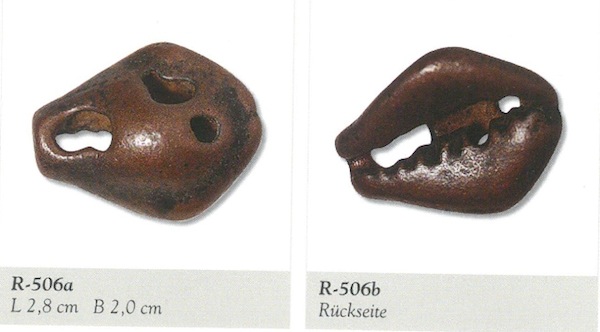
Fig. 6. The two sides of another bronze cowry of significant age. This photograph comes from the book by Gudrun John, 2006: Tibetische Amulette aus Himmels-Eisen, p. 164, Rahden: Verlag Marie Leidorf.
This copper alloy thokcha in the form of a cowry has a hemispherical cross-section. Along the aperture is a row of denticles. As with the bronze cowry examined above, these denticles are prominent and few in number. The narrow side of the shell is nearly square. The large hole near this end appears to have increased in size through use. The wear on this attachment loop, which occurred over a long period of usage, is discernable in the photograph. The other two holes in the object may have occurred when it was cast and which have expanded over time. This copper alloy cowry has a very fine coppery patina.
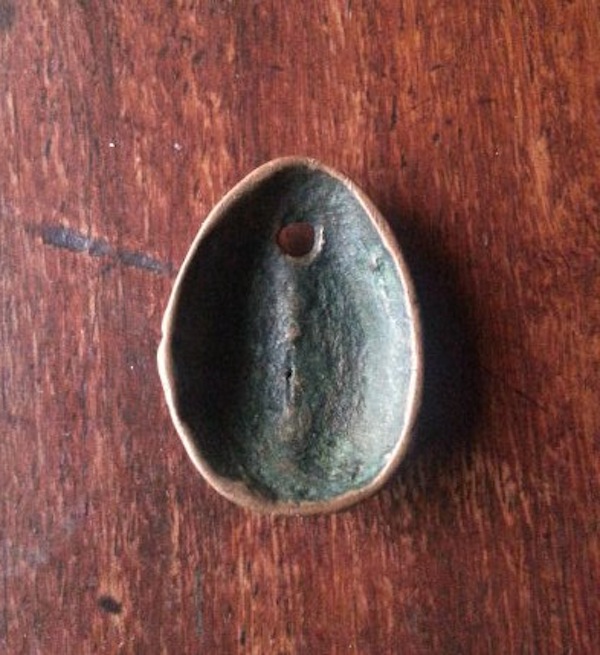
Fig. 8. Reverse side of the copper alloy cowry in the Dawa Gyaltsen collection. Photo courtesy of Dawa Gyaltsen.
A third copper alloy cowry found in Tibet is now in the Dawa Gyaltsen collection. It varies from the other two depicted, constituting a third style. Its shape, profile and identifying features are closer to Chinese variants, and import from China in the distant past or more recently must be considered. This object exhibits much wear, suggesting that it was worn or handled over a long period of time.
I am of the opinion that the first two copper alloy cowries featured in this article (figs. 4–6) are Tibetan cultural objects, not imports from other countries. They have distinctive morphological traits not found in other metallic cowries, were prized as being valuables worth conserving, and have stylistic qualities of Tibetan thokcha talismans. Cowries are not a common subject in thokchas, suggesting that this class of metal objects did not function as money in Tibet. Had they done so, many more should have come to light, including those cached in hordes.
The variations in the forms of the three copper alloy cowries depicted above seem to indicate significant differences in age and place of manufacture. This is not surprising for an artifact as deeply ingrained in Tibetan culture as the cowry. These imitation cowries are all of considerable age but they lack a provenance, which would be useful in placing and dating them more accurately. I suspect that the three cowries are attributable to either the protohistoric period (100 BCE to 650 CE) or early historic period (650–1000 CE), but there are no means at my disposal with which to confirm this attribution. Perhaps the specimen in fig. 6 is even more ancient, dating to the Iron Age, but again, this is just speculation.
Chinese bronze cowries used as currency are different in form and appearance from the ones I assign to Tibet. They are often found in multiples and buried underground. Thus they suffer from unsightly bronze disease. Chinese specimens tend to be almost pointed on one end. The majority of them have a large linear opening in the middle flanked by many small denticles. Furthermore, many Chinese bronze cowries are slightly arched. They may be considerably older than the Tibetan examples. Chinese bronze cowries are generally dated to the Shang (1600–1046 BCE) and Zhou (1029–221 BCE) dynasties.
For Chinese bronze cowries see, for example, the following websites:
Wikimedia Commons website:
Bronze cowries excavated from the Linzheyu site in Baode County, Shanxi, dated to the Shang dynasty (circa 1600 BCE–1100 BCE).
See: http://commons.wikimedia.org/wiki/File:Bronze_cowries_.jpg
Anything Anywhere website (a commercial undertaking):
Photographs of Chinese cowries made of various materials including bronze, jade and stone, dated imprecisely to the Shang and Western Zhou dynasties (circa 1400–900 BCE)
See: http://www.anythinganywhere.com/commerce/coins/coinpics/chin-fd2.htm
NumisMall website (a commercial undertaking):
Image of Chinese bronze cowry, dated to the Western Zhou dynasty (1046–771 BCE). There are other Chinese bronze cowries pictured on this website under other URLs.
EarthMetropolis website:
Image of bronze cowry with gold leaf, a solid center and with a hole on one end for attaching a cord. This specimen has rounded ends and is rounded in profile. It is dated to late Shang dynasty or early Zhou dynasty (circa 13th–8th centuries BCE). Despite its solid center, this imitation cowry is considerably different in form than the two examples attributed to Tibet in this article.
See: http://www.earthmetropolis.com/Definitions/definiti.htm
For a brief essay on the use of cowries as money in ancient China, see the British Museum website. It notes that cowry shells and imitation cowries were deposited in tombs as money for the dead.
See: http://www.britishmuseum.org/explore/highlights/highlight_objects/cm/c/cowrie_shells.aspx
The following webpage also furnishes basic information about the use of cowries as money in ancient China: http://www.conchsoc.org/pages/MW_6_p19-21a.pdf
On the the possible parallel use of knucklebones and cowries as a kind of sacred currency in ancient times, see R. Holmgren, 2004: “’Money on the hoof’ The astragalus bone – religion, gaming and primitive money”, in PECUS.Man and animal in antiquity. Proceedings of the conference at the Swedish Institute in Rome, September 9-12, 2002 (ed. B. Santillo Frizell), Rome: The Swedish Institute in Rome.
See: http://www.isvroma.it/public/pecus/holmgren.pdf
According to the paper by Ke Peng and Yanshi Zhu (1995) (see bibliography above) cowries first appeared in northwestern China in tombs of the Majiayao Neolithic (3300–2000 BCE). These authors observe that they spread from the northwest to the central plains of China during the Shang and Zhou dynasties. Ke Peng and Yanshi Zhu (1995) theorize that cowries reached ancient China from the Red Sea via the Near East, Turkmenistan, Lake Baikal, and Mongolian steppe. They add that other cowry roads to ancient China must have also existed, given the universality of this object in many ancient cultures.
The discovery of cowries from the Indian ocean in the tombs of the Slab Grave culture indicates that they reached Mongolia through far-reaching trade links, which encompassed China, Central Asia, and Afghanistan (Antiquities of Upper Tibet, after Ishjmats 1994). Given the antiquity of cowries in Tibet and the central geographic position of the Plateau, it may well have been part of this same network of trade and distribution.
It is generally agreed upon that the origin of cowry use in ancient China was informed by trade links to Inner Asia. This strongly suggests that cowries in Tibet (an integral part of Inner Asia as its most southern region) belonged to an independent line of cultural development, with no direct links to Bronze Age or Iron Age China. This generally holds true for all categories of archaeological evidence in upper, central, and most other regions of Tibet in the Bronze Age, Iron Age, and protohistoric period. We can view the copper alloy cowries discovered in Tibet as part of endogenous patterns of cowry shell exploitation on the Plateau. That Tibetans deemed the cowry fit for reproduction as copper alloy objects implies that they possessed considerable value as economic, social or religious entities. More specifically, the metal cowry is likely to express the intrinsic apotropaic or talismanic value of cowries, something this shell still possesses in Tibet.
On a bigger scale, we can see cowry use in Tibet as part of a widespread cultural phenomena reaching from China to Arabia and Africa. Far from being a closed off land existing in isolation, the Tibetan Plateau of ancient times was an interactive part of a world that transcended the bounds of individual cultures, languages and ethnicities. Whether it is astragali or cowries, chariot art or mortuary long stones, Tibet’s development in ancient times appears to have quite closely matched those of other regions near and far. This cosmopolitanism is intrinsic to the fabric of Tibetan civilization, a potent force that shaped its very character and scope.
Archaeological sites in Upper Tibet: Accelerating pace of destruction
In 2013, the damage and destruction of archaeological sites in Upper Tibet continued unabated. Much of the degradation of archaeological assets in the region is due to ignorance, not criminal intent. The single biggest factor in explaining the increased loss of archaeological sites is economic growth. Chinese road building remains a big cause, but destruction by the Tibetans themselves is picking up momentum. Stones are needed for local construction projects and in some places archeological sites provide a convenient supply.
As I know from my interactions with Upper Tibetans, they often want new roads, better housing, electricity, and other facilities. If only this development could be conducted with an eye towards cultural heritage and posterity, much of the problem would be solved. While the looting of ancient tombs remains a grave problem (pardon the pun), there is a growing awareness among authorities about the gravity of the situation.
In this article, I will review some of the more egregious examples of damage to archaeological sites that has occurred recently in Upper Tibet. Other examples must have escaped my attention. It is not possible to comb the vast region in a decade, let alone on a single trip. I hope that this catalog will spur on the concerned authorities to take greater action. May it also be an appeal to ordinary Tibetans as well, for they are directly responsible for much of the loss of their own cultural heritage. Unless Tibetans better understand what is at stake, even the best efforts of the Chinese government will not have the intended effect.
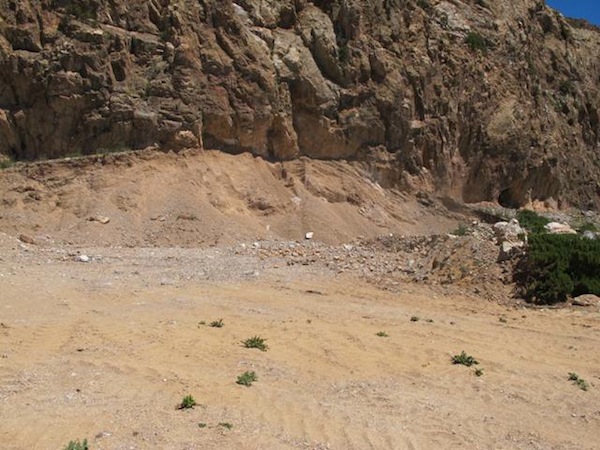
Fig. 9. A bit of the new road along the north shore of Lake Nam Tsho constructed in 2013. A number of ancient cave shelters and rock faces were harmed by the building of this road. Perhaps planners could reconsider the utility of roads along uninhabited lakeshores. These environments are ecologically and culturally delicate with their migratory bird habitats, archaeological sites and pristine waters. Furthermore, routes directly on lakeshores tend to be tortuous and less efficient than inland ones.
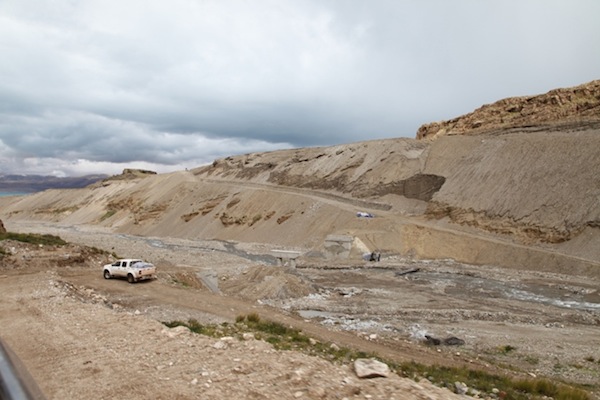
Fig. 10. The road in the Sokpo gorge along the east shore of Lake Dangra finished in 2013. A new concrete bridge is being constructed at the site. The villagers of Lake Dangra are pleased to finally have a motorable road, which makes getting around far easier and faster. The road was so planned to have minimum impact on the landscape. Still, like any road in such a delicate environment, there are considerable ecological impacts.
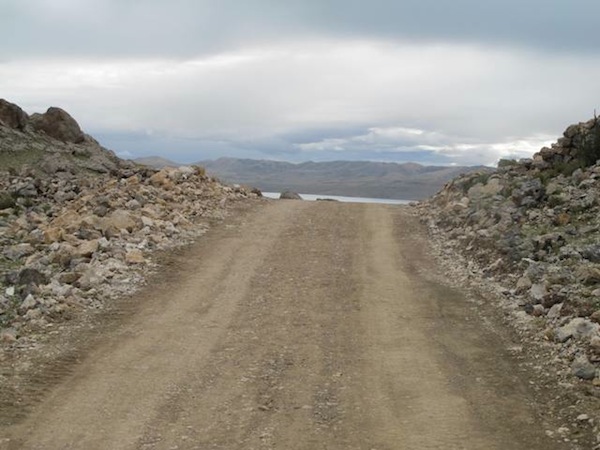
Fig. 11. The new Lake Dangra road traversing the Khyung La pass. This road cuts through one of the ancient defensive walls at Dangra Khyung Dzong, the fabled castle of the Zhang Zhung kingdom’s last king, Likmigya. The construction of just one additional culvert-like structure could have saved this archaeological structure from damage.
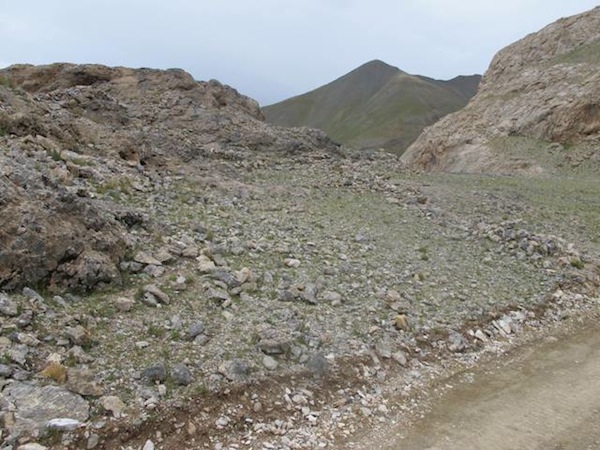
Fig. 12. Ancient rampart traces at Khyung La, Lake Dangra. With the new road, cultural and environmental impacts are likely to increase, as they do virtually everywhere in the world when a new road is cut through a remote location.
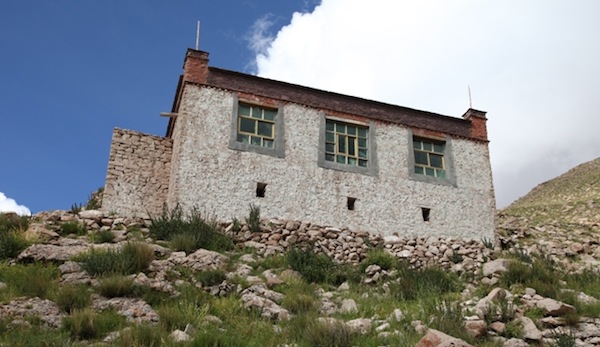
Fig. 13. The retreat house built circa 2011 at Lhalung, Lake Dangra. This house was constructed by the reincarnate lama of a local Bon monastery, mainly from materials pilfered from a nearby archaeological site. This retreat house lies vacant.
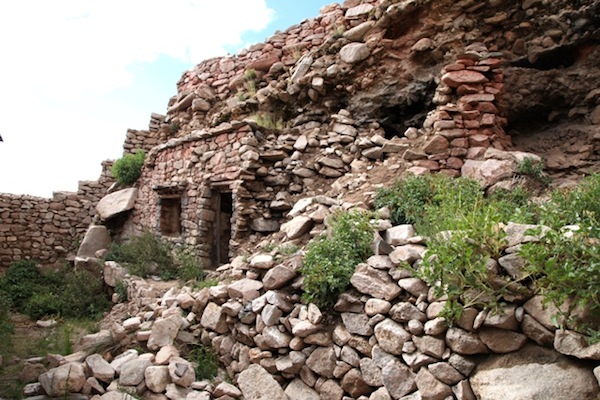
Fig. 14. The ancient retreat house of Lhalung located just behind the new construction. This structure stood unobtrusively for centuries. Destabilized by the building of the oversized new retreat house, it succumbed to an earthquake a couple years back.
For more information on this site and its various ancient residential structures, see “Lha lung sgrub phug” in Antiquities of Zhang Zhung:http://www.thlib.org/bellezza/#!book=/bellezza2/wb/c1-3/
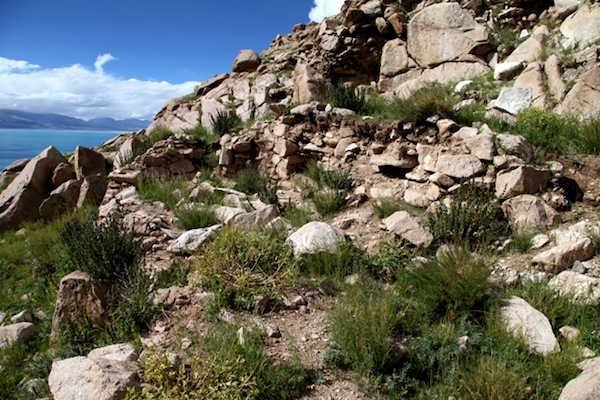
Fig. 15: One of two all-stone corbelled structures at Lhalung mined for stones by a local reincarnate lama, in order to build the new retreat house. This important archaic structure was so heavily pilfered that it is hardly recognizable any longer. This is a significant loss to the ancient culture heritage of Lake Dangra, made all the more tragic because it was perpetrated by local Tibetans. Ironically, the lama who oversaw the dismantling of this building belongs to the Bon religion, the Tibetan faith that is supposed to most value Zhang Zhung and its enormous legacy to Tibet. The destruction of the Lhalung archaeological site is an egregious example of what ignorance can wreck. Tibetans do not traditionally much value old and broken down buildings and art, preferring to create anew. However, when it comes to sensitive archaeological structures, they do themselves a great disservice by razing them, for they erase from the land signs of their own ancient tenure.
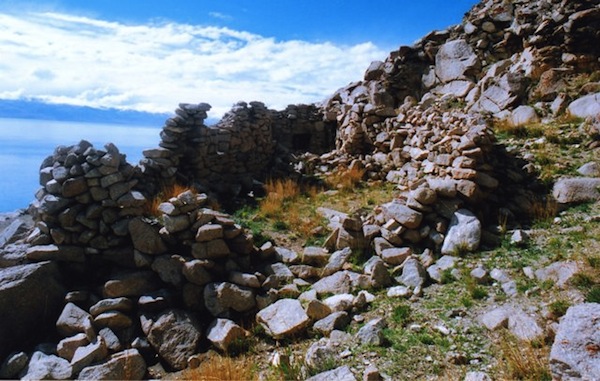
Fig. 16. A photograph of the same ancient building in fig. 15 taken in 2004, before most of the stones were carted away by Tibetans to construct the modern building. Many of the characteristic traits of all-stone corbelled buildings are visible in this image.
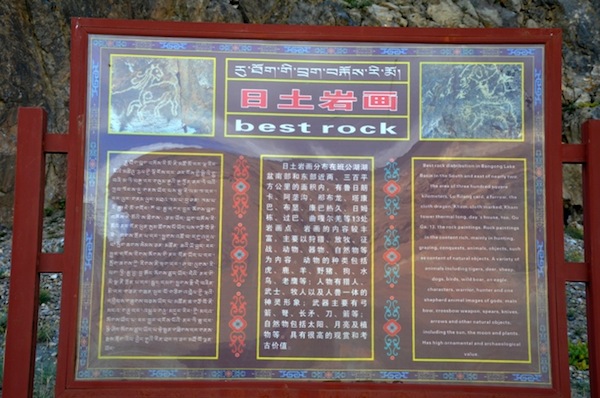
Fig. 17. A signed announcing a rock art site in Ruthok known as Nowayangdo (rNo-ba g.yang-rdo, spelling?). This site is located in the gorge upstream of the town of Ochang (O-byang). Only small vestiges of rock art now remain.
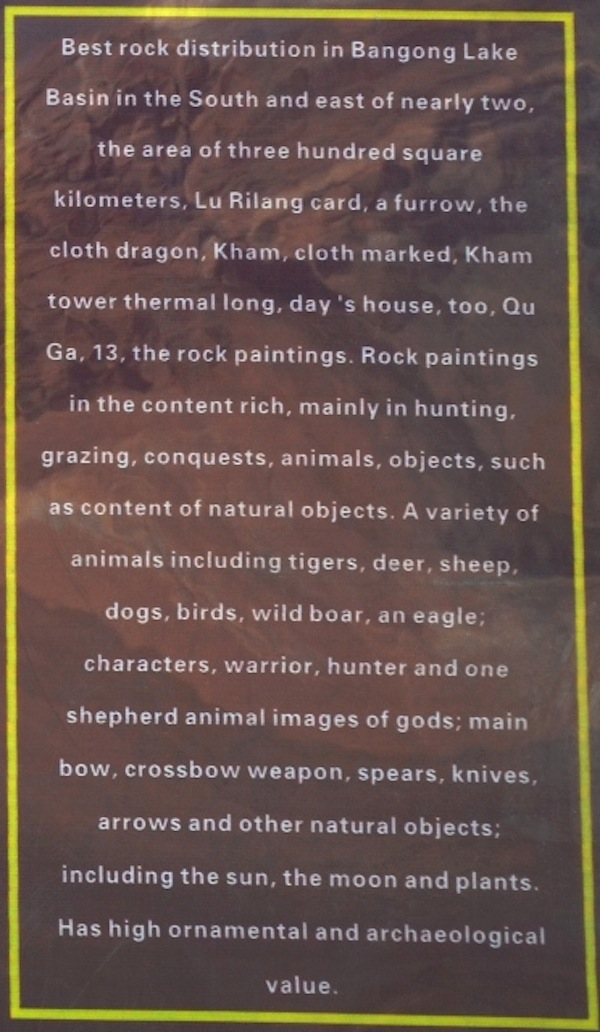
Fig. 18. A close-up of the English text on the signboard in fig. 17. This notice was erected recently, as part of a government effort to better register rock art sites for tourism. The sign stands in front of two chortens carved after 1000 CE. Most of the rest of the site, including it most valuable prehistoric panels were destroyed several years ago by the construction of a dam. This important rock art now lives on only in my photographs (most of which are still unpublished) and those of anyone else who might have once visited the site.
For an impressive image of a priest, shaman, or deity from the now destroyed Nowayangdo site, see: L. Bruneau, L. and J. V. Bellezza, 2013: “The Rock Art of Upper Tibet and Ladakh: Inner Asian cultural adaptation, regional differentiation and the ‘Western Tibetan Plateau Style’”, p. 148, in Revue d’etudes tibétaines, vol. 28, pp. 5–161. Paris: CNRS.
See: http://himalaya.socanth.cam.ac.uk/collections/journals/ret/pdf/ret_28.pdf
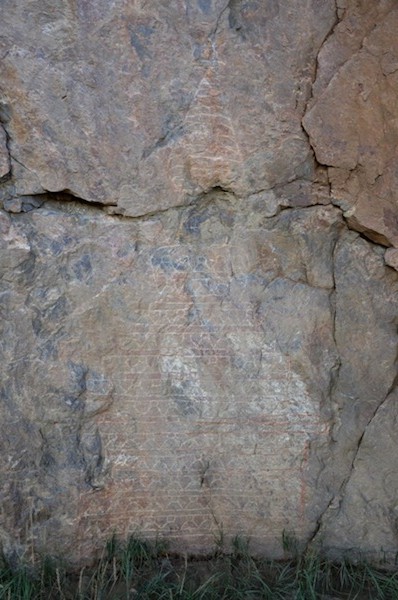
Fig. 19. One of the two remaining carved chortens at Nowayangdo. The more important early art was lost when a new dam was constructed in the gorge looming above the village.
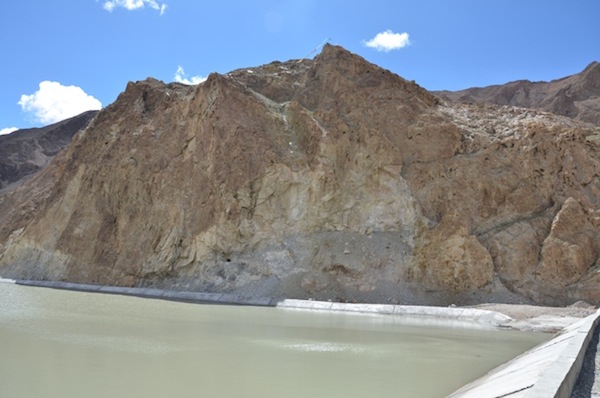
Fig. 20. The new dam at Ochang. The main panels of the Nowayangdo rock art site were situated in the area of the rock formation blasted away in order to construct the dam. The large destroyed areas are much lighter in color than rest of the rock formation. Several years ago another important rock art site known as Luring Nakha (Lu-ring sna-kha) was also all but eradicated by the widening of a road. See the January 2012 Flight of the Khyung.
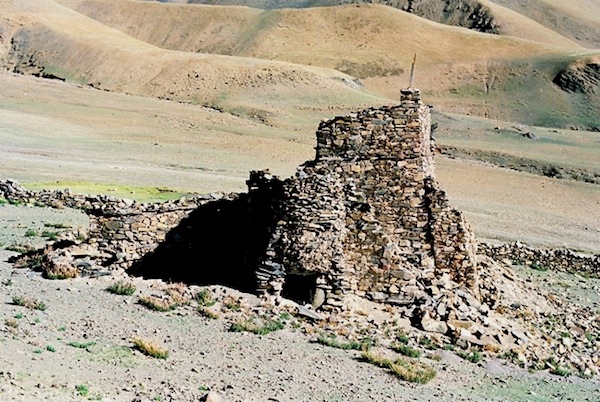
Fig. 21. One of the most intact all-stone corbelled religious edifices in Upper Tibet. Photograph taken in 2006. Known as Monlam Dzong (sMon-lam rdzong: Supplication Castle), the survival of this ancient building can be attributed to its takeover by Buddhist practitioners, circa the 15th century CE. It was maintained and used by Nyingma monks for retreat until the modern period. Historical records show that it belonged to the Bonpo circa the 11th century CE.
For more information on this important archaeological site, see forthcoming: “The Ancient Corbelled Buildings of Upper Tibet: Architectural attributes, environmental factors and religious meaning in an unique type of archaeological monument” in Journal of Comparative Cultural Studies in Architecture, special edition for proceedings of the International Association of Tibetan Studies XIII, Ulan Bator.
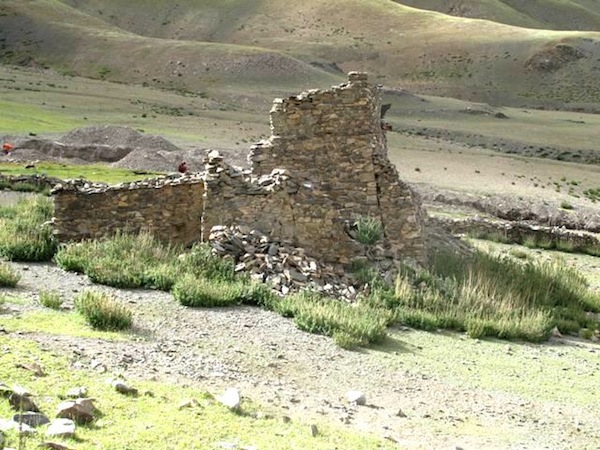
Fig. 22. Monlam Dzong in 2013. No longer maintained by local Nyingma monks, the structure is rapidly deteriorating. Note how much of what appears to have been the latrine (middle of structure) has disappeared. Unless conservation measures are soon instituted this precious piece of Tibetan architecture heritage will continue to wither away.
Next Month: An insular hub of ancient civilization in Upper Tibet, and the region’s most extensive brick-and-mortar shrines!
